The first indication we have of an active alumni body comes from the Maryland School Journal of 1877, edited by M. A. Newell, who served as the Maryland State Normal School (MSNS) principal from the day it opened in 1866 until 1890.

From that one sentence, we can gather that this reunion was not the first for graduates of MSNS, but that there was not yet a formal “alumni organization”.
The school was only 11 years old at that point, so it isn’t too surprising that not much had yet been put in place for graduates of the school. The fact that they were meeting with students who were currently enrolled at MSNS also suggests that this reunion was more about passing along the experiences of what it was like to work in the field of teaching as much as it might have been to see old friends and reminisce about the good times had in previous years.
The school was a lot different in 1877. The curriculum lasted only 2 or 3 years, depending on a student’s academic success. There were no dormitories and while the literary societies were definitely in place by that point, perhaps there was not much time for students to spend socializing and getting to know each other.
That one sentence is all that we have related to graduates returning to the school for the next 17 years.
In 1894, Sarah Richmond wrote in her office diary that there was an Alumni Association banquet the day after commencement.

While we don’t have records or documents that tell us exactly what happened, there is evidence which shows that as the school evolved the Alumni Association solidified.
An 1893 Baltimore Sun article listed eight Alumni Association officers at M. A. Newell’s funeral, including D. Edward Stauffer who served as president. Stauffer and C. Hervey Perdee, who was president after Stauffer, are both listed in an 1897 article about planning the next reunion.
Information about the Alumni Association’s activities and officers continues to be sparse until MSNS moved to its Towson location.
While the school had been discussing the need for a move since just after the turn of the 20th century, Sarah Richmond, a graduate of the Class of 1866 and MSNS principal, 1909-1917, imbued the discussion with new urgency.
A letter-writing campaign began in the Alumni Association to contact legislators and persuade them to provide funding for a new campus for the school.
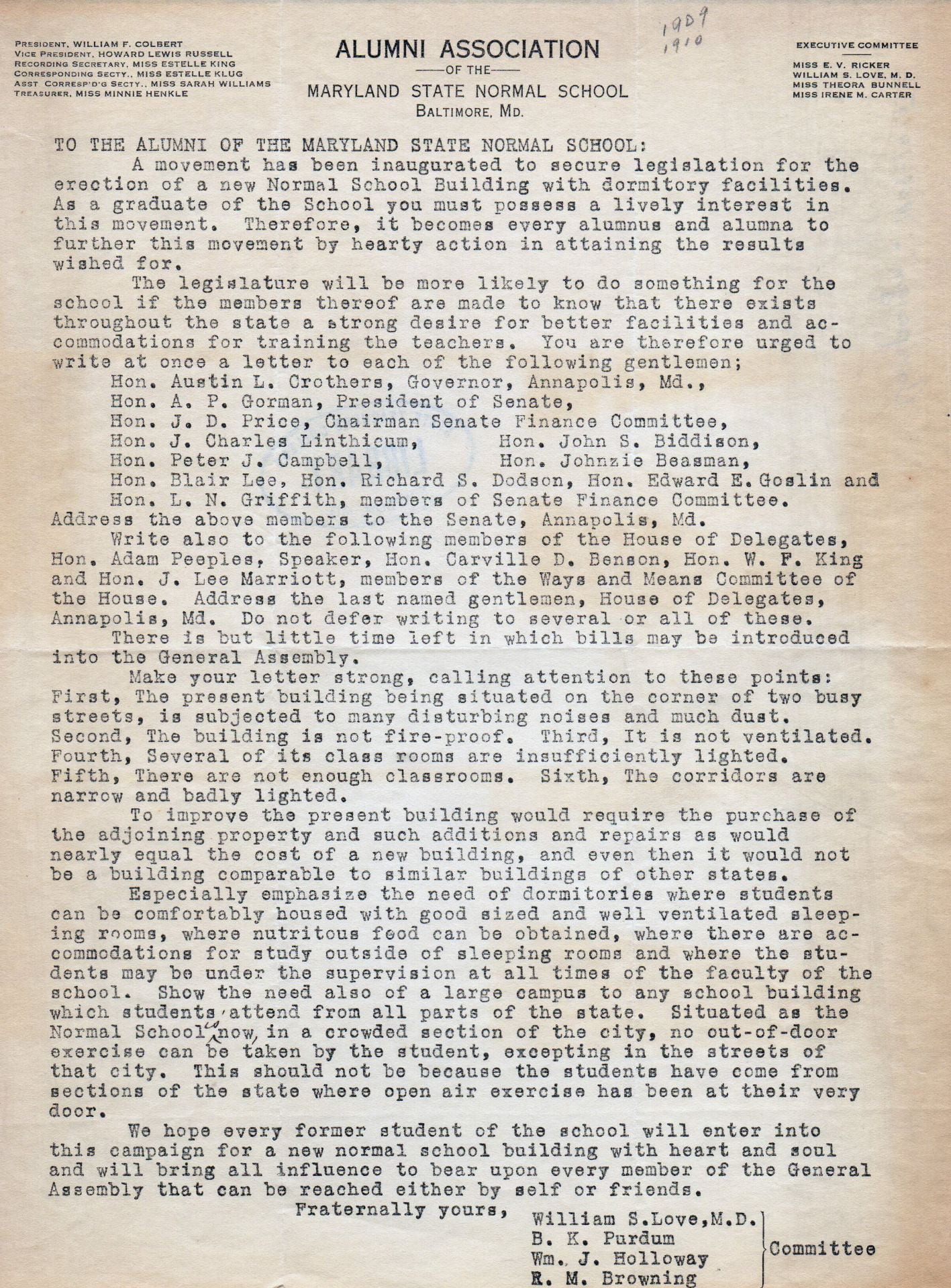
Ultimately, the school was granted money by the Maryland General Assembly to relocate, and the president of the commission established to move the school was Class of 1866 graduate J. Charles Linthicum, Maryland State Senator until 1911, and then U. S. Congressman.
The Alumni Association honored Richmond in 1916 for her 50 years of service to the school. At that time, she was given a tea service and the sugar bowl contained $500 in gold coins. When she died in 1920, she bequeathed the tea service to MSNS, and the money she’d invested from the gold coins was turned into a loan fund for incoming students. This fund was the first form of monetary assistance the school offered. The fund remained in place until 1970 when it was folded into a general fund by the newly established Towson University Foundation, Inc.
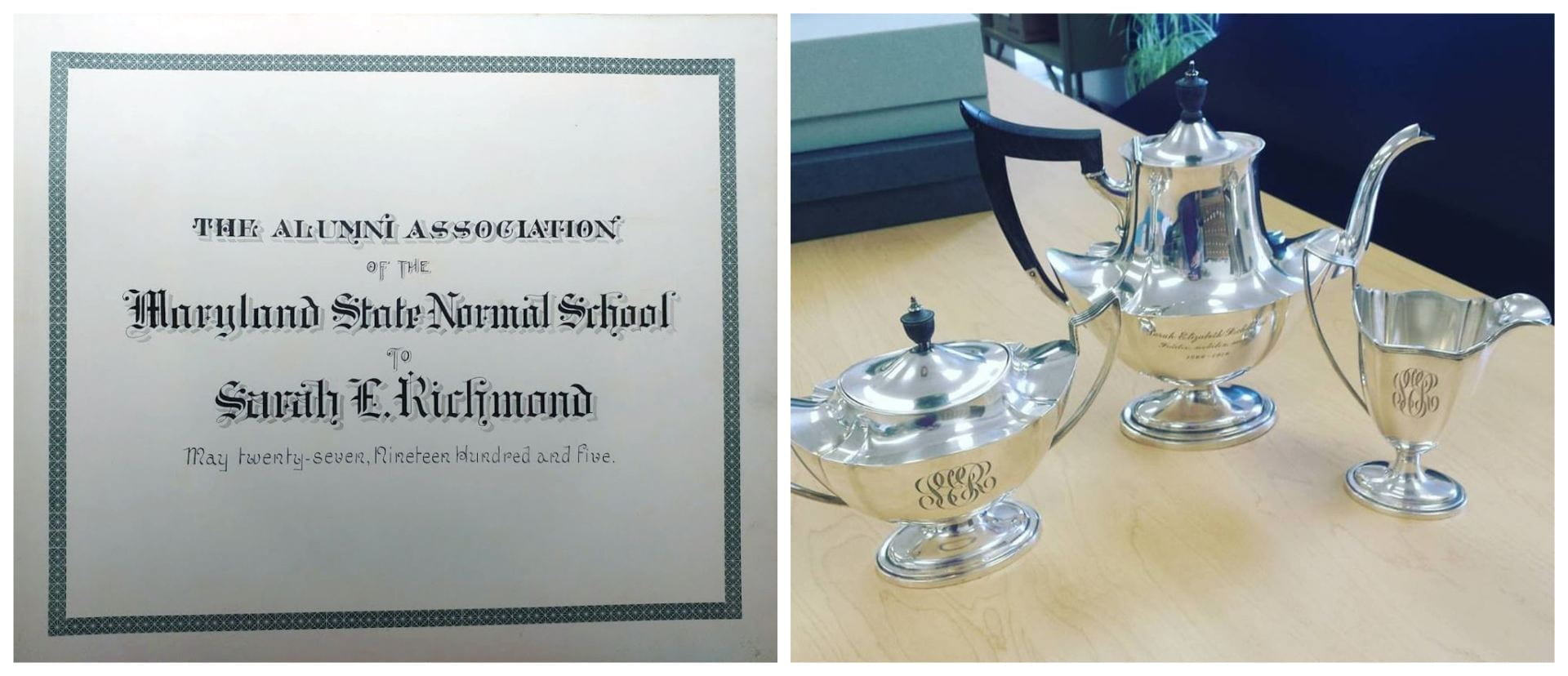
The move to the Towson campus perhaps was the ultimate piece needed to finally cement a strong alumni organization. We have records of the presidents and officers for the Alumni Association beginning in 1923. Linthicum himself served as president for 1925/1926 and 1926/1927.
We also have budget books from the 1930s that show that dues were $1 per year. A letter from Sarah Richmond during her years as principal suggest that had been the case for some time. The dues, presumably, paid for the luncheon reunions that the school held for alumni every year after graduation as well as educational lectures and other events deemed worthy by the Alumni Association.
It was hoped that an increase in membership of the Alumni Association would also allow that body to hire someone to help run the organization and also create an endowment or scholarship. The Alumni Association was a volunteer organization: all the events, lectures, and reunions were planned by committees of volunteers.
With the move to a larger campus, the Alumni Association also began hosting “home-coming” events which at first centered on mentoring those enrolled in the school about real-life experiences working in the teaching field. The day often culminated with more entertaining fare like soccer games, card parties, dances, and plays.
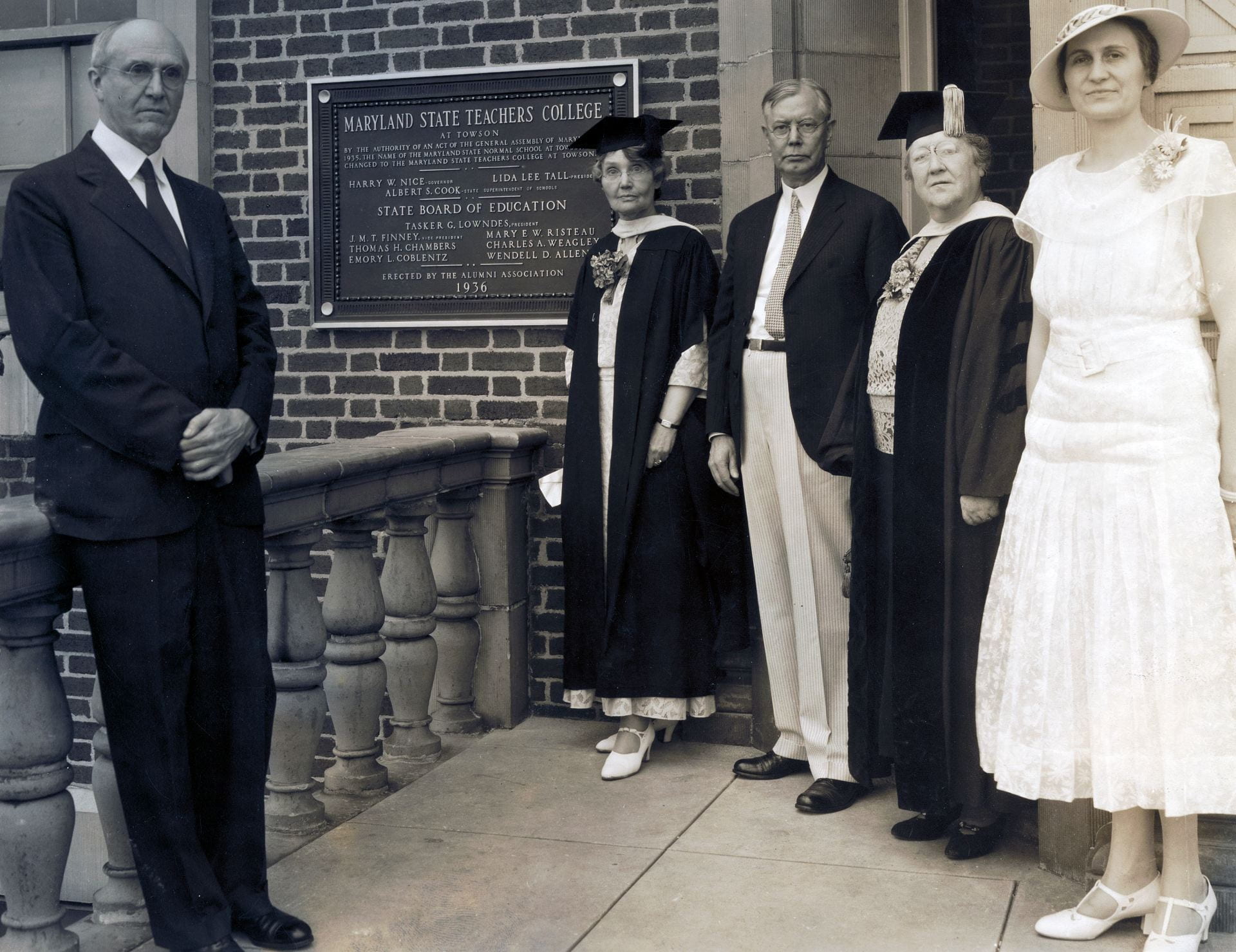
This photograph of the installation of the Alumni Association-sponsored plaque reflecting the change from MSNS to the State Teachers College (STC) has three alumni in it:
- Mary Hudson Scarborough, Class of 1891, served as the principal of the Model School, and also taught math at MSNS and STC.
- Frank C. Purdum was a member of the Class of 1893. A man of many talents, he went on to pharmacy school and owned a pharmacy in the Hamilton neighborhood in Baltimore, served as a member of the Maryland House of Delegates from 1927 to 1929, and played the flute in the Johns Hopkins Orchestra. He was the Alumni Association President, 1932-1935.
- Ruth Parker Eason succeeded Purdum as Alumni Association President and remained in the office until 1937. She was a graduate of the Class of 1915. Her long career in education included serving as the director for special education for Anne Arundel County.
The relationship between STC and alumni took on new meaning with the appointment of M. Theresa Wiedefeld to the President’s office in 1938. Wiedefeld herself was a 1904 graduate of MSNS and an active member of the Alumni Association until her death in 1983. Under her leadership, a list of the Alumni Association officers began appearing in the course catalogs along with a brief description of the organization’s activities. At the time catalogs were used as marketing as well as informational tools so this inclusion would have highlighted the importance of the Alumni Association to the school itself.
This partnership would become even more imperative during World War II. Using connections with the Alumni Association, school administrators reached out to those serving both nationally and globally, and then shared information with the campus community through a newsletter.
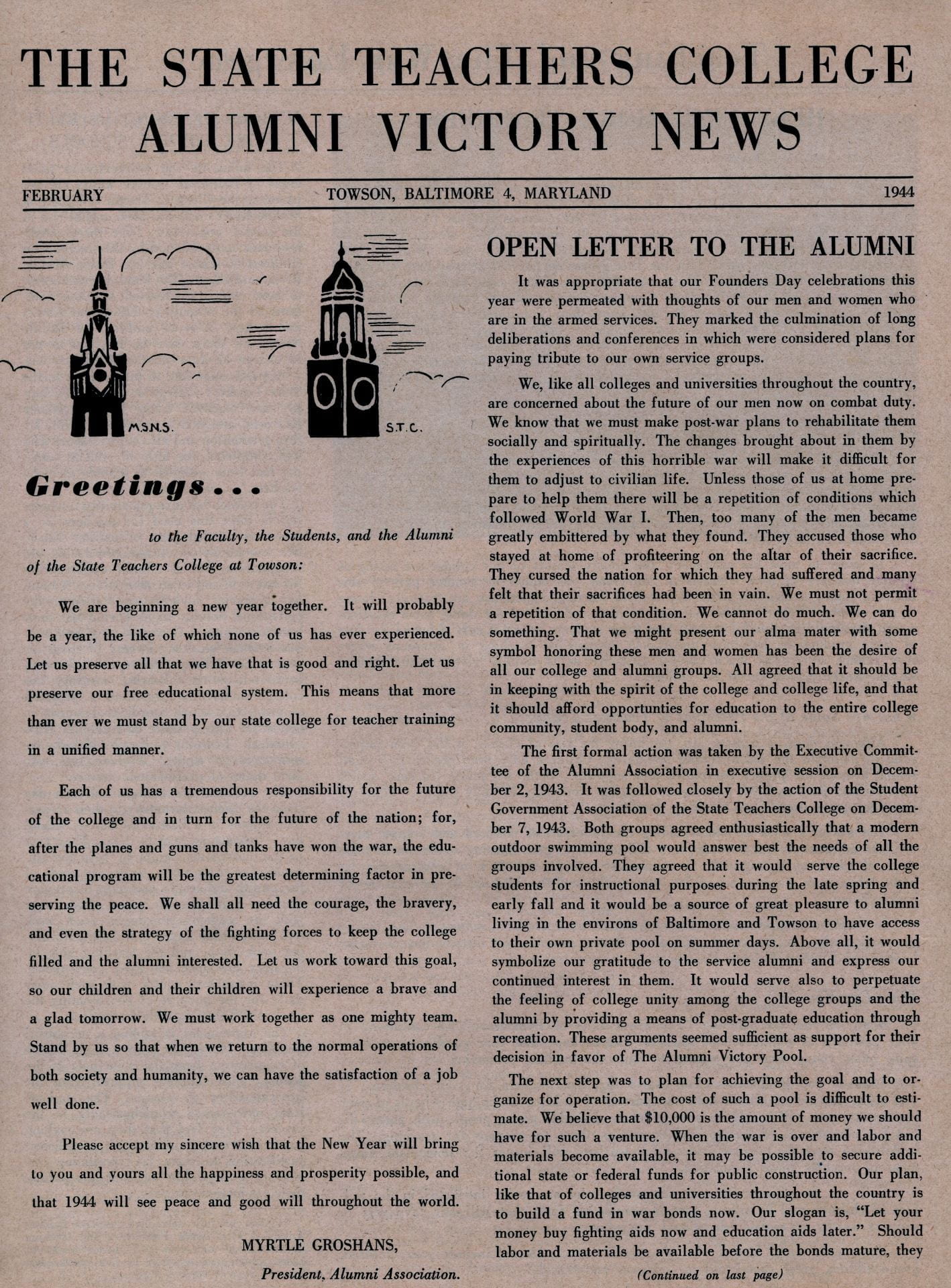
The newsletters contained not just school news, but information regarding the locations of service members. And, as can be seen in this example, those who were not serving in the armed forces still wanted to find ways to contribute to the effort. Here, we see the call for funds through war bonds — investing money now for the war by buying bonds that could be cashed in after the end of the war. The school decided to raise money for the Alumni Victory Pool.
After the war, the work of the Alumni Association became more formalized. Stories about alumni activities became a more regular part of the Towerlight. Awards become standard parts of the annual Alumni Day Banquet which celebrated milestone reunions for every graduating class.
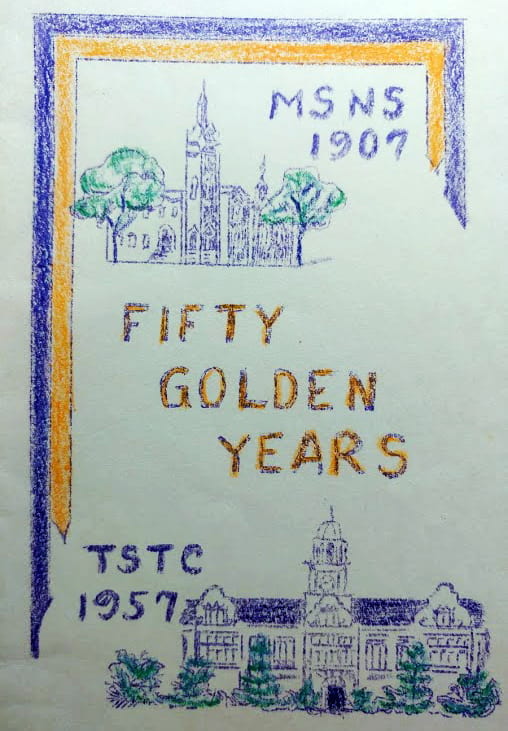
There was finally enough money to not only sponsor programming and events, but the Alumni Association could hire an Executive Secretary to help keep all the records organized.

By the 1980s banquets and celebrations had grown from evenings to full weekend celebrations, often centered around Homecoming. Also in the 1980s, the Alumni Association began publishing a magazine featuring stories celebrating the accomplishments of Towson alumni.
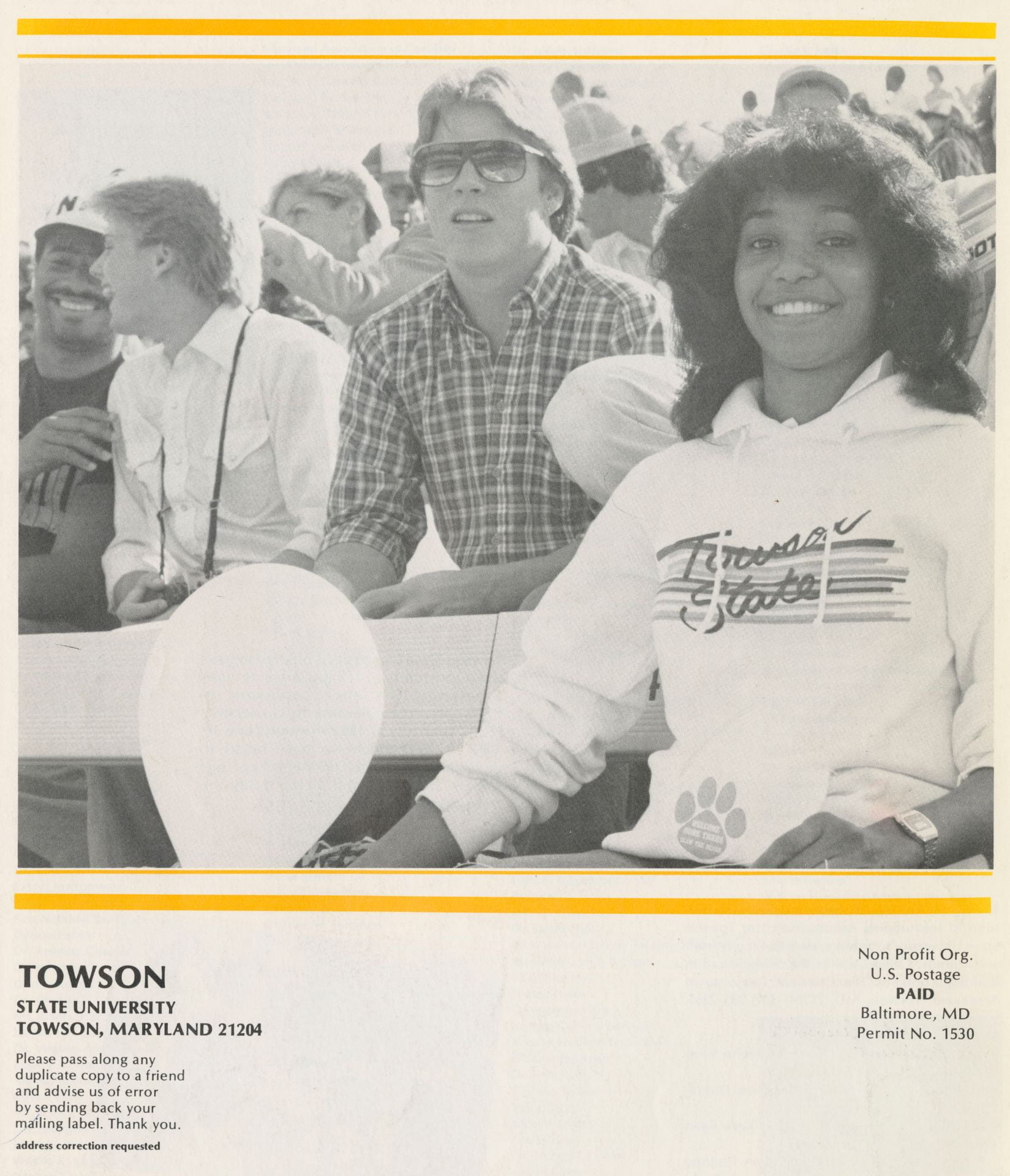
While there were few events outside of the Alumni weekend held on campus for alumni, they were invited to attend sporting events, performing arts events, gallery events, lectures, and to join the University Club as well as donate money during the annual phonathon campaign.
In the 1990s, realizing that Towson alumni now lived far from Maryland, mini-reunions began popping up in various cities across the country, inviting former students to meet, regardless of their year of graduation.
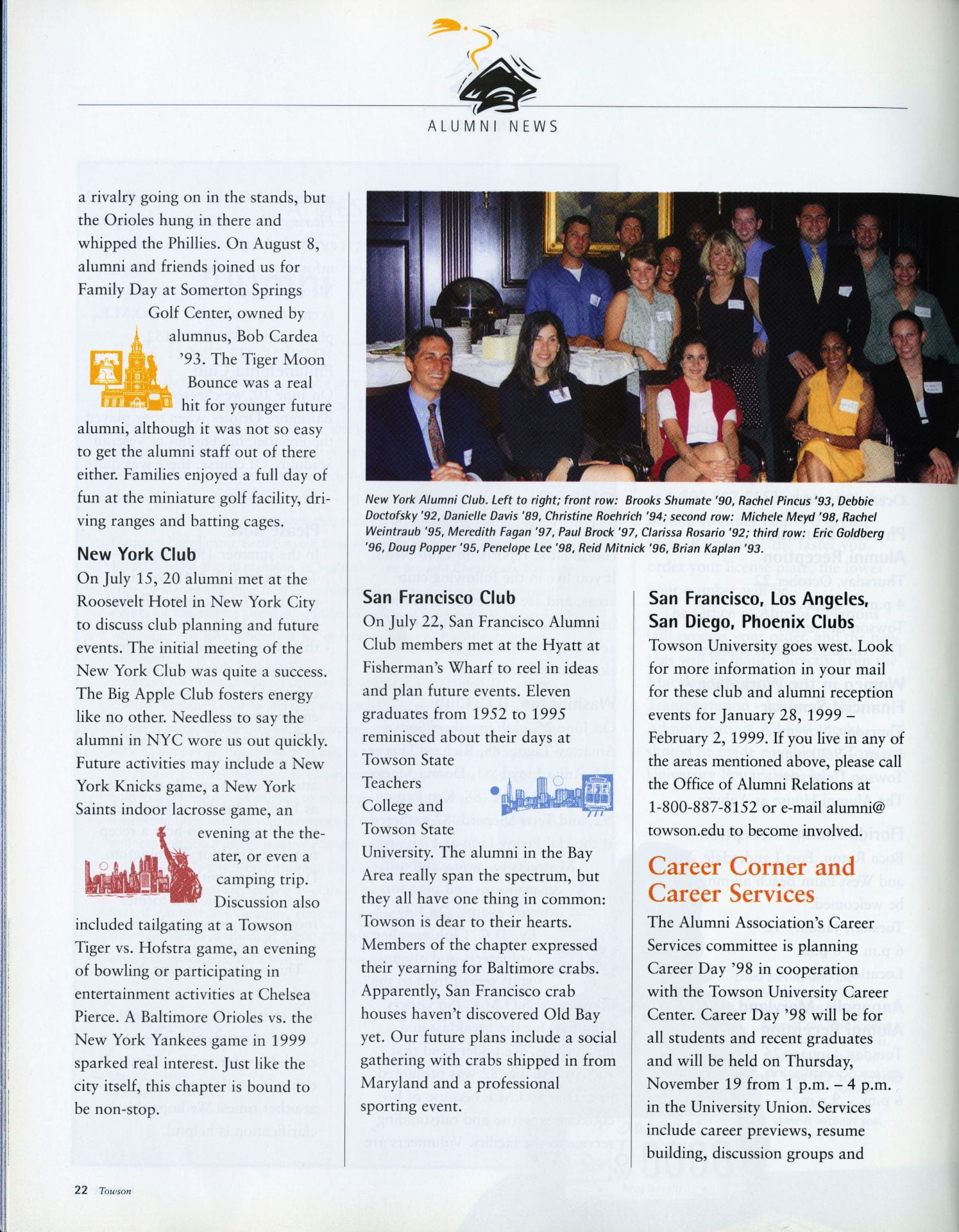
As the school has grown, the Alumni Association and the Office of Alumni Relations has sought ways to continue to engage our growing body of alumni. Rather than concentrating on one long weekend or event, alumni gatherings have become more frequent and diverse. During the 2018/2019 academic year, alumni could choose to spend the day together at Hersheypark or on a ski trip. They could meet current students at meetings with various diversity organizations or offer their experiences as part of career events, or attend arts or sporting events. There were crab feasts and brewery visits, and trips to Annapolis to tell legislators how much TU has meant to former and current students. Faculty and staff members who are also alumni had their own mixer. And, of course, the Class of 1968 celebrated their 50th reunion.
Today marks the beginning of our spring commencement ceremonies, which of course means that Towson University alumni will grow by the thousands during the three-day event. Not only will they be graduates of a school with a long and rich history, but the Alumni Association they will now be part of has just as long a tradition.
Welcome to our newest Towson University alumni!

